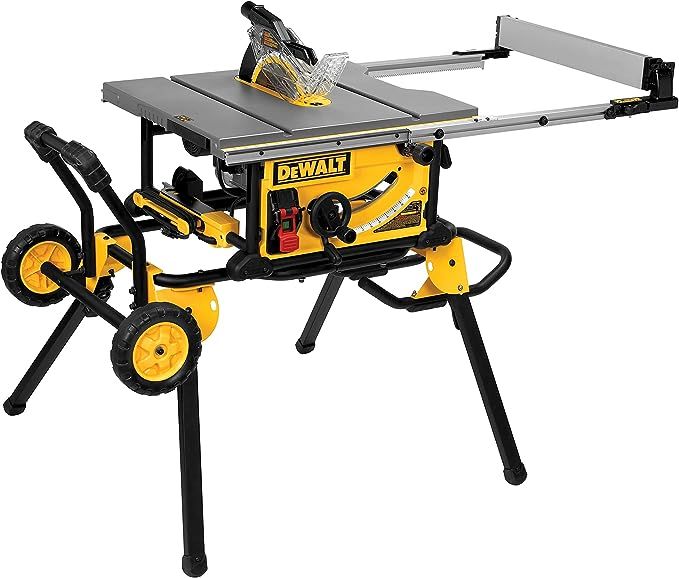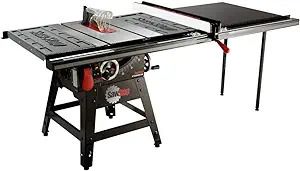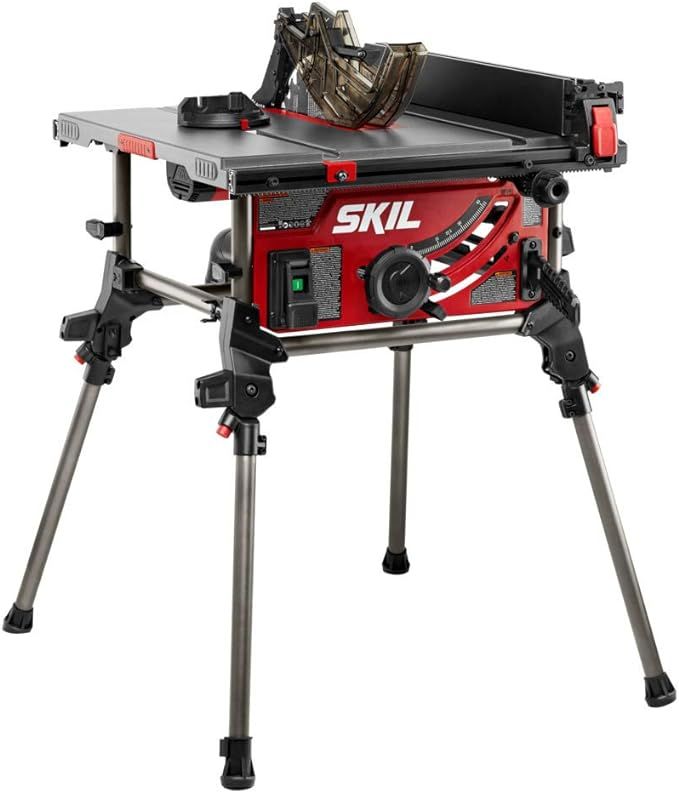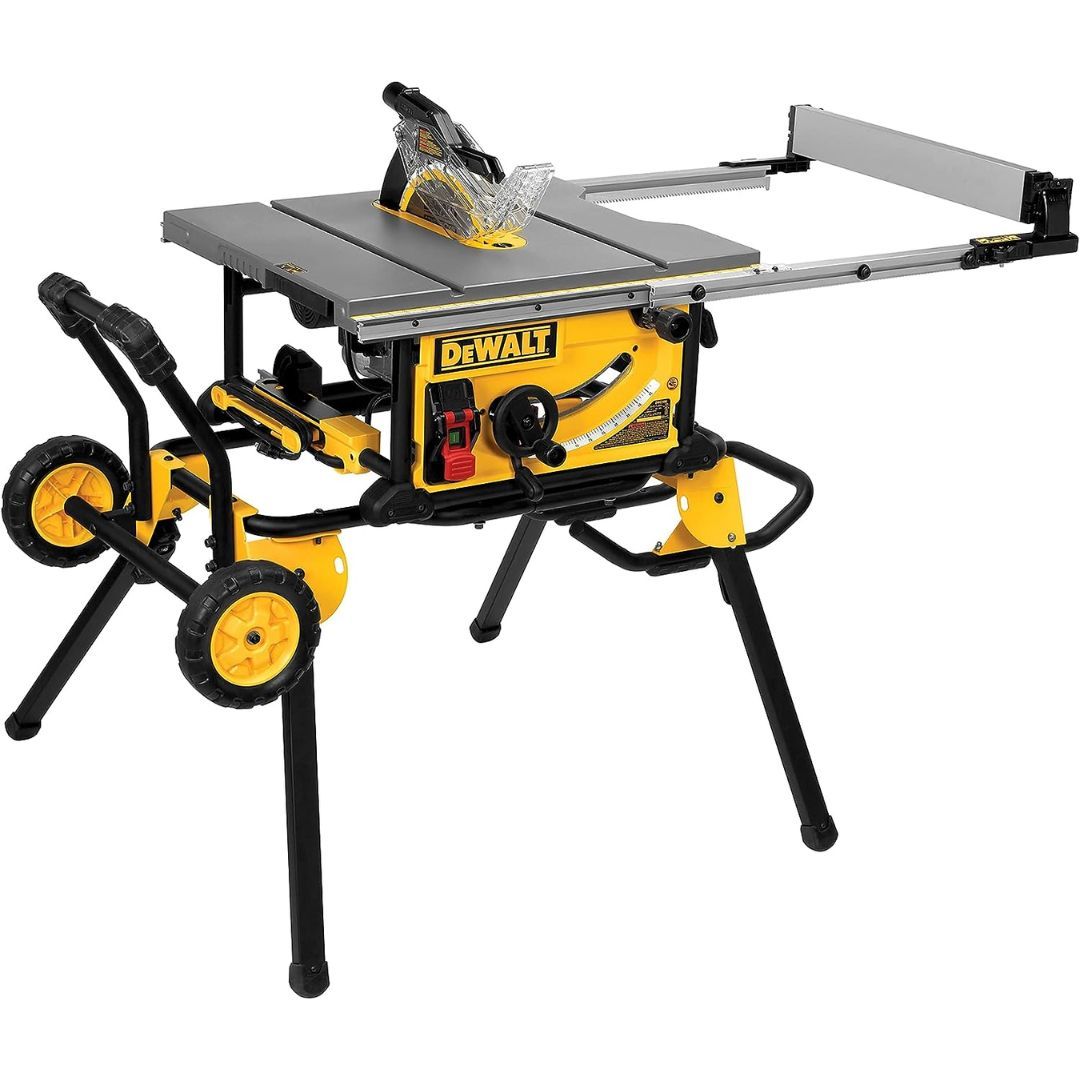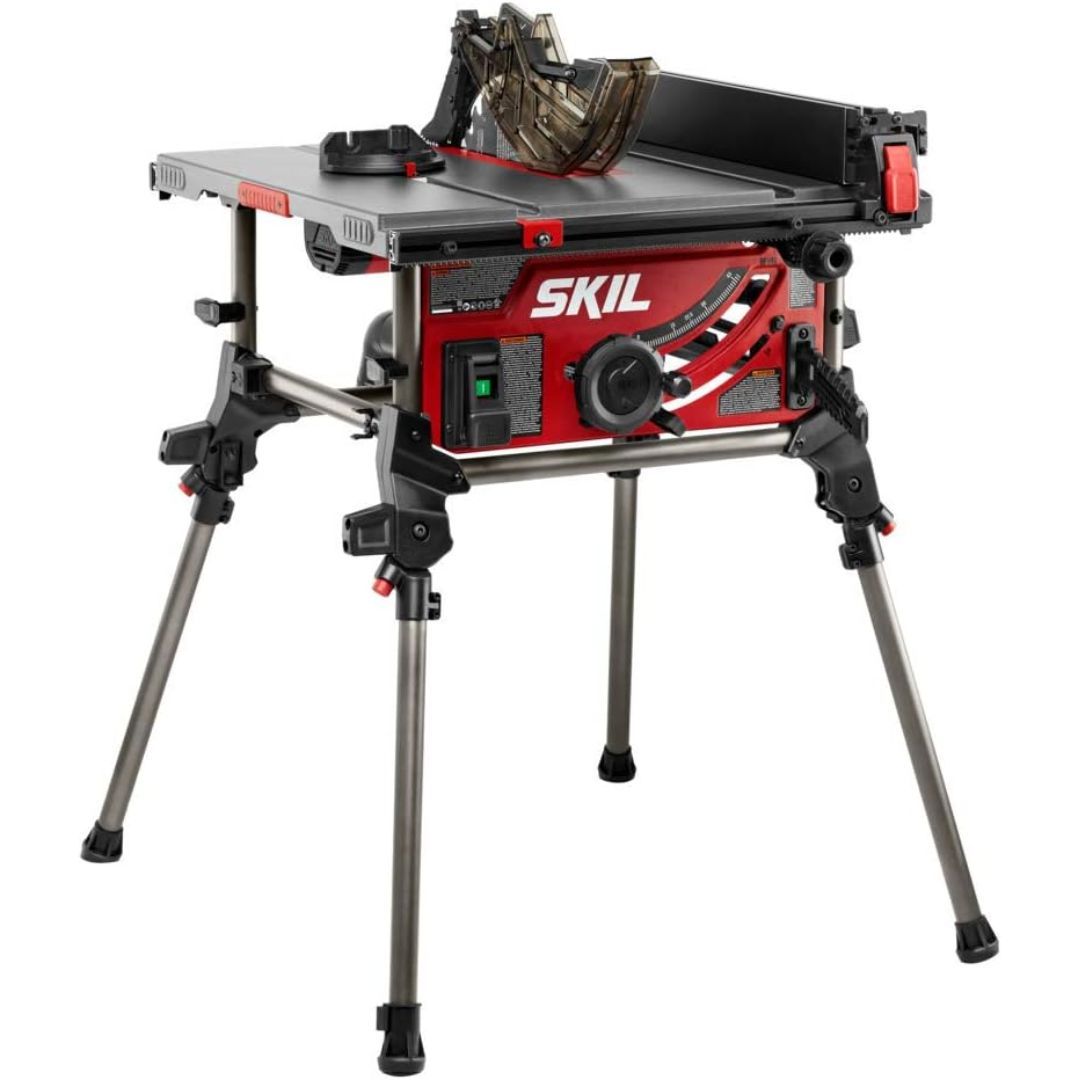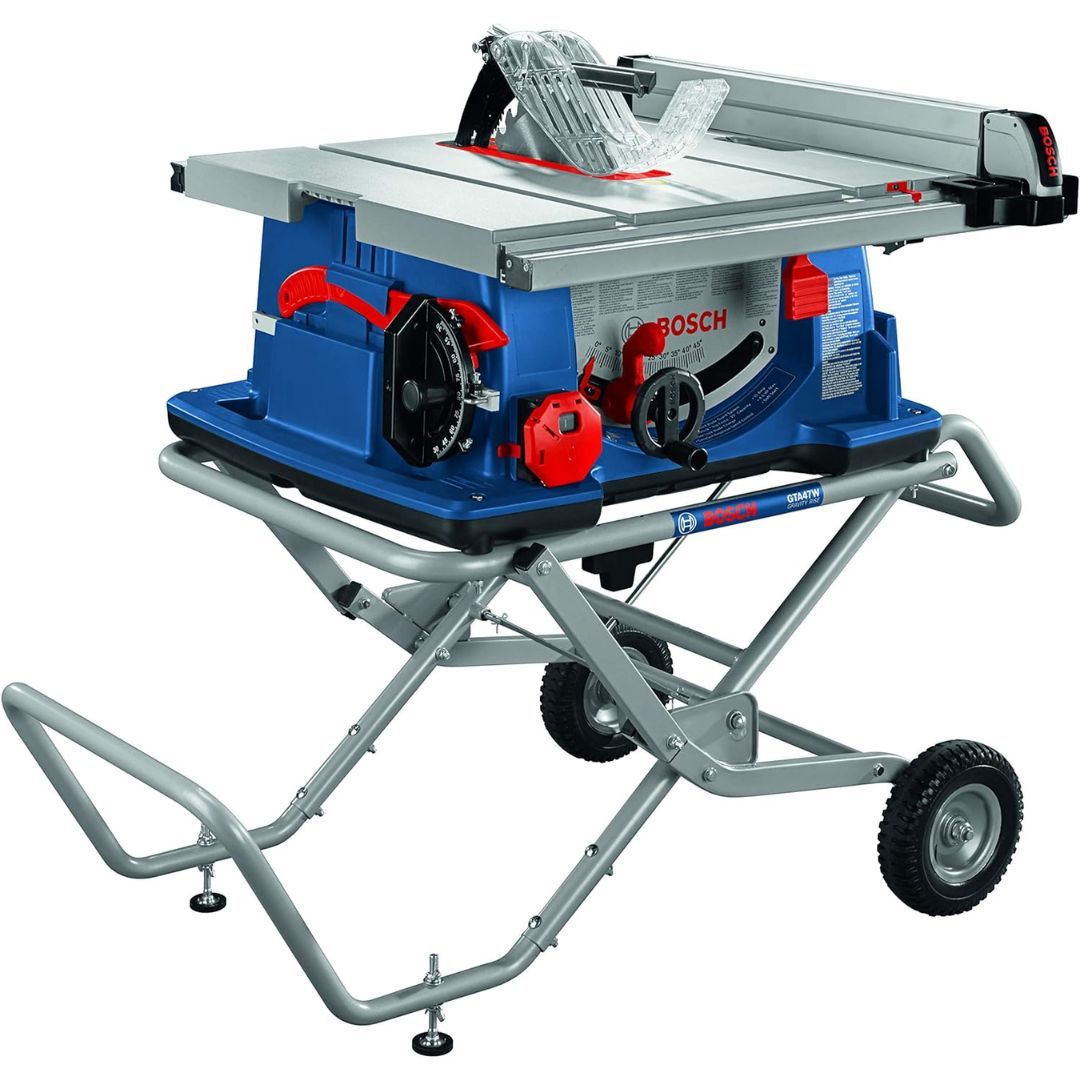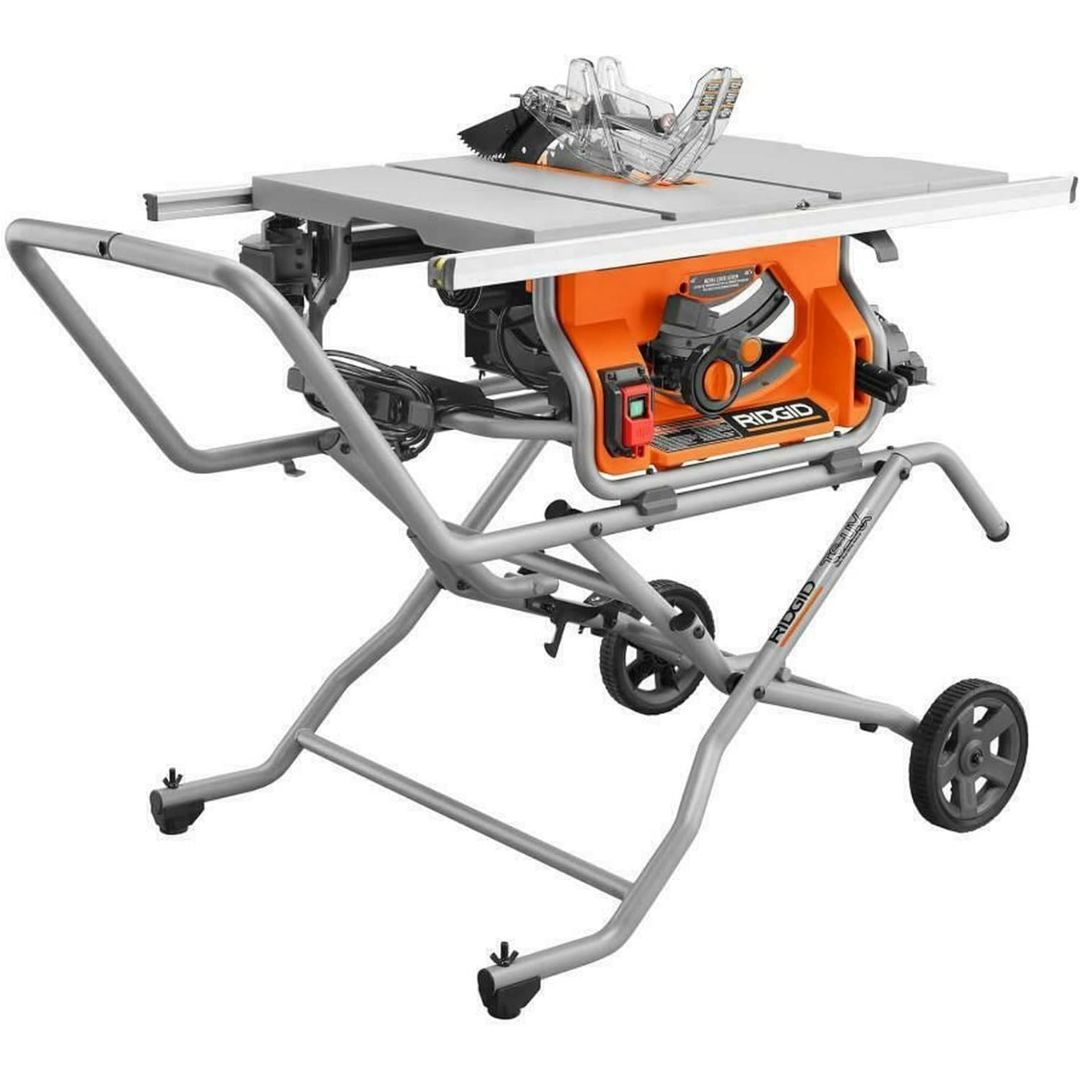We may be compensated if you purchase through links on our website. Our Reviews Team is committed to delivering honest, objective, and independent reviews on home products and services.
When working with wood, there are few tools more useful than a high-quality table saw. Table saws are powerful devices that allow you to cut through wood and other materials with minimal effort. Whether you’re a seasoned woodworker or a beginner tackling a new DIY project, there’s a table saw out there for you. We researched the best table saws available on the market to help you narrow down your options. Here are our top picks.
Top 5 Table Saws
- Best Overall: DEWALT DWE7491RS Table Saw
- Best Heavy Duty: SAWSTOP 10-Inch Contractor Saw
- Best for Beginners: SKIL Portable Jobsite Table Saw
- Most Portable: BOSCH 10 In. Worksite Table Saw
- Best Jobsite: RIGID Pro Jobsite Table Saw
Compare Top Table Saws
| Product | Cutting Diameter | RPM | Power Level | Dimensions | Weight |
|---|---|---|---|---|---|
| DEWALT DWE7491RS Table Saw | 10 inches | 4800 | 15 amps | 31 x 24.5 x 31 inches | 110 pounds |
| SAWSTOP 10-Inch Contractor Saw | 10 inches | 3000 | 15 amps | 84.5 x 19.5 x 44.7 inches | 362 pounds |
| SKIL Portable Jobsite Table Saw | 10 inches | 4600 | 15 amps | 28.7 x 27.2 x 16.9 inches | 51.5 pounds |
| BOSCH 10 In. Worksite Table Saw | 10 inches | 3650 | 15 amps | 32.5 x 27 x 13 inches | 110 pounds |
| RIGID Pro Jobsite Table Saw | 10 inches | 5000 | 15 amps | 24.5 x 39.3 x 13.8 inches | 98 pounds |
| Product | Cutting Diameter | RPM | Power Level | Dimensions | Weight |
Best Overall
Good for: DIYers who need a reliable, well-built table saw for home projects.
What Customers Are Saying
We find that customers who give this saw positive reviews like that it’s highly powerful and easy to use. Others comment on its portability and plethora of useful safety features. On the other hand, some reviewers feel this saw has too small of a work surface, and others say the table is not flat enough. Some also say this product is too loud.
Best Heavy-Duty
Good for: Professionals or serious DIYers who want a professional-level contractor table saw for heavy-duty projects.
What Customers Are Saying
Customers who give this product positive reviews are pleased with its power, noting that it cuts through 4-by-4 lumber smoothly. Others like that it’s portable and that it’s easy to align the blade. However, some customers note that the saw’s fence is difficult to balance, and others feel it lacks precision.
Best for Beginners
Good for: Those seeking a basic but well-performing table saw that can manage standard DIY tasks.
What Customers Are Saying
Our team finds that customers who give this saw positive reviews like how lightweight it is and how easy it is to lock the fence into place. Others like its wide cutting surface. However, a few customer reviews mention that the riving knife is difficult to adjust, and others are disappointed in some of the parts’ lack of sturdiness.
Most Portable
Good for: Those who need a portable saw with a large stand that delivers powerful cuts and has numerous safety features.
What Customers Are Saying
We find that customers who give this product positive reviews like that it’s easy to maneuver, operates quietly, and delivers powerful cuts. However, several customers note how challenging this saw is to assemble, and others say the fence is not high quality.
Best Jobsite
Good for: Those who need a top-quality portable saw with a powerful motor they can easily move around the jobsite.
What Customers Are Saying
We notice that customers who give this product positive reviews like that it consistently makes smooth cuts, operates quietly, and is simple to set up and put away. On the other hand, some reviews mention that this saw’s fence is not well-designed, and others say the stand is not sturdy.
What To Know Before Buying a Table Saw
There are several factors to keep in mind when purchasing a new table saw. Consider things such as saw type and power level as well as cutting depth, blade size, and rip capacity to find the best tool for your needs.
Saw Type
There are many types of table saws to choose from, including the following:
Benchtop Saws
Benchtop saws are compact and designed to fit on your workbench, typically weighing less than 60 pounds. They’re a good choice for beginners and moderate DIYers, as they provide enough power to perform basic tasks but aren’t overly complex and don’t take up too much space.
Contractor Saws
These saws are designed for serious DIYers and have higher price points than benchtop saws. They are typically stationary and heavy-duty. A contractor saw is a good choice for those serious about woodworking who need a more powerful tool than a benchtop table saw.
Cabinet Saw
Cabinet saws are professional-grade table saws that are most often used in professional woodworking settings. They have a motor that’s fully enclosed in a cabinet below the saw. These saws can cost as much as $5,000.
Hybrid Saw
Hybrid table saws combine the features of contractor and cabinet saws. They’re designed like cabinet saws (but typically do not have the same circuit requirements) and have the power levels of contractor saws.
Power Level
A table saw’s power level is measured in horsepower, with benchtop models typically ranging from 3/4 to 1 1/2 horsepower and contractor saws reaching up to 4 horsepower. A standard benchtop saw’s horsepower will be plenty for most moderate DIY tasks, but some materials, such as thicker sheets of metal that are larger than 2 inches, will require a more powerful saw. Table saw power is often listed in amps to indicate how many amperes the tool draws.
Cutting Depth and Blade Sizes
A table saw’s cutting depth indicates the blade size it can accommodate. Most saws are 10 or 12 inches, and most blades are also either 10 or 12 inches to match this cutting depth. Some compact saws will have smaller blades, typically 8 1/2 inches, while some contractor or cabinet models will exceed 12 inches.
Rip Capacity
A saw’s rip capacity indicates the distance between the saw blade and the fence. Saws with broader rip capacities will be better at ripping wide boards and other larger materials. Entry-level saws will have rip capacities of around 18 inches, while larger professional saws can exceed 50-inch rip capacities.
Tips for Properly Using a Table Saw
Using a table saw can be tricky, even for experienced users. If you’re new to using a table saw or need a refresher on getting the most out of your machine, check out our tips on how to use a table saw.
- Read the tool’s manual before use and follow all safety guidelines. When operating a table saw, wear proper eye and ear protection, such as safety glasses and headphones.
- Understand the cut you’re trying to make. For example, rip cuts go with the wood’s grain, while cross cuts go against the grain.
- Never operate a table saw if you are inebriated or overly tired.
- Check the blade carefully before use, and do not use the saw if you notice any cracks or missing teeth.
- If you need to make multiple cuts across the same length, attach scrap wood to the rip fence and set the distance between the scrap and the blade to the desired length.
- Be intentional about your blade choice. If you’re unfamiliar with the various options, check out this guide to understanding saw blades.
- When you finish your project, clean the saw with a hand brush or cordless blower.
- For more information on how to properly use a table saw, check out the video below.
Here are some visual guides to help you ensure your safety when using a table saw.
Before Using the Saw
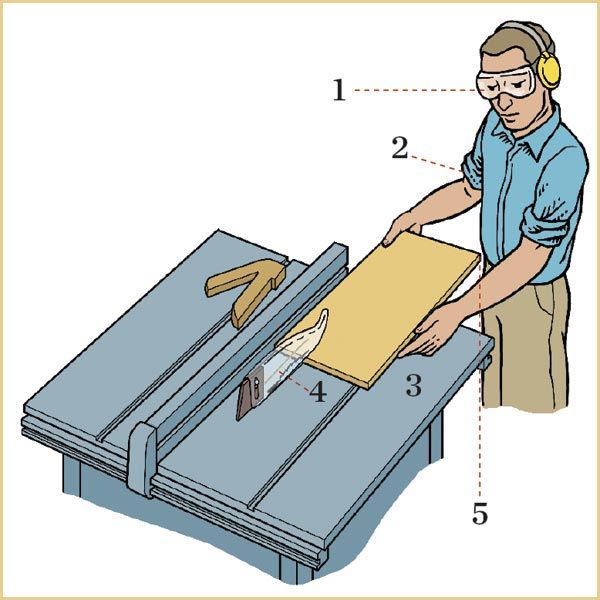
1. Put on eye and ear protection.
2. Roll up sleeves, tuck in shirt.
3. Remove any clutter from tabletop and underfoot, and make sure saw is stable.
4. Set blade ¼-inch higher than thickness of wood.
5. Stand to one side of workpiece and blade.
When Using the Saw
1. If motor strains, don’t force wood through blade. Shut off saw, and try new piece or new blade.
2. Whenever blade is less than 6 inches from fence, use push stick. Otherwise, hook fingers of pushing hand over fence to keep them clear of blade.
3. Watch kerf where wood exits blade. If it gets pinched, immediately stop saw and get new workpiece.
4. Always guide workpiece using fence. Never cut freehand.
5. Hold your control hand in one location, between you and blade, bracing workpiece against fence as you feed it through blade with other hand.
TOH Tip: Before every rip cut, measure the distance from the fence to the miter slot, front and back. If the measurements are the same, kickback is far less likely. – Norm Abram, TOH master carpenter
How to Check a Saw for Accuracy
It’s important not to assume a saw will make accurate cuts out of the box. Run these tests on a new table saw to ensure it’s good to go before using.
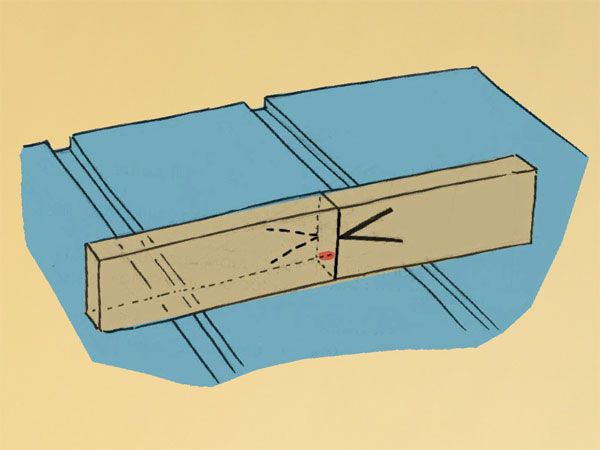
Crosscuts: Set the miter gauge at 90 degrees, mark an X on a board, and crosscut through the X. Now flip the right-hand piece so that its marked side faces the opposite way. Butt the cut ends together, and set both pieces on edge on the saw table. If there’s a gap at the joint, adjust the gauge and repeat the test until the gap disappears.
Rip cuts: Slide the edge of a straight ¾-inch-thick board into the table’s miter slot. Place a block of wood next to the board, and slide the fence against the block and lock it down. If the block doesn’t slide freely between, and remain in contact with, both the fence and the board over the fence’s entire length, adjust the fence and try again.
FAQ About Table Saws
What safety features should I look for in a table saw?
Table saws are required to have a blade guard, which you should ensure is secure before operating the device. Additionally, look for anti-kickback pawls, push sticks, riving knives, and safety stops to help keep you protected.
Do table saws work on materials besides wood?
Table saws can be effective at cutting materials other than wood, such as aluminum or sheet brass. They can also work on plastic. However, you should not use a table saw on tough metals. Instead, try using a circular saw.
What kind of stand do you need for a table saw?
Table saw stands, such as this one from DEWALT, help keep your bench saw in place. Some saws come with a stand, but not all of them do, so check the product listing carefully. Larger saws, such as contractor saws, typically come with a stand for the saw to operate on.
What are the best table saw brands?
There are dozens of brands that make table saws, but some of the most reliable include the following:
- Bosch
- Craftsman
- DEWALT
- Grizzly
- Makita
- Milwaukee
- RIGID
- Ryobi
- SawStop
- SKIL
Who This Table Saw Guide Is For
You can use a table saw for a variety of woodworking jobs and other projects. They make cutting through thick materials easy and help you create anything from a new table to a birdhouse to brand-new cabinet doors for your home.
To help you choose the best table saw, the This Old House Reviews Team created this table saw guide and considered a variety of table saw types, including bench, jobsite, and contractor saws. We looked at models at various price points, sizes, and horsepower levels to help you find the best option.
How We Selected the Best Table Saws
To provide our readers with the best recommendations possible, we rely on several key sources of information to help guide our selection process.
Initial Research: Our research process began by generating a list of table saws with a significant number of verified-buyer reviews and an average customer review rating of 4–5 stars. We looked at positive and negative reviews alike, focusing on information from both satisfied and critical buyers.
Expert Insights: Through our years of experience, we’ve learned that listening to what others have to say is key to building accurate, well-rounded articles. To complement our in-house expertise, our team looked at reviews and videos from trusted publications and independent testers, spoke with subject matter experts, and drew insights from reader contributions.
Final Product Selection: We then began fine-tuning our list by replacing older models with the latest versions and eliminating any discontinued models. From there, we pared the list down further by comparing each model’s feature set and selecting the best-in-class options for various buyers, budgets, and scenarios.
Why You Can Trust Us
This Old House has empowered homeowners and DIY-ers for more than four decades with top-notch home improvement advice in the form of television programs, print media, and digital content.
Our team focuses on creating in-depth product and service review content. To date, we’ve published over 1,600 reviews on products in the home space, from doorbell cameras and backyard fencing to pool vacuums and snow blowers.
Once we conclude our research, we craft a comprehensive, user-friendly article of recommended products and additional information to help our readers make the right purchase.
Questions or Comments?
To share feedback or ask a question about this article, send a note to our Reviews Team at reviews@thisoldhousereviews.com.
